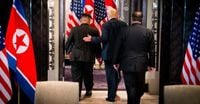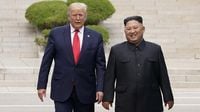In a revelation that has sent ripples through diplomatic and military circles, a classified U.S. Navy SEAL mission in early 2019 aimed at intercepting North Korean leader Kim Jong-un’s communications ended in failure and tragedy, according to multiple reports published on September 5, 2025. The mission, orchestrated by SEAL Team 6—the elite unit famed for taking down Osama bin Laden—was authorized at the highest levels of the Trump administration. Its objective: plant a sophisticated electronic device capable of eavesdropping on Kim’s most sensitive conversations, potentially tipping the scales during a tense period of nuclear diplomacy.
The New York Times, which first broke the story, detailed how the operation unfolded against the backdrop of a rare thaw in U.S.-North Korea relations. President Donald Trump and Kim Jong-un were engaged in a series of high-profile summits, including historic meetings in Singapore (June 2018), Hanoi (February 2019), and the inter-Korean border village of Panmunjom (June 2019). These encounters, marked by bold gestures and sweeping declarations, raised cautious hopes for resolving North Korea’s nuclear ambitions—a puzzle that had frustrated U.S. administrations for decades.
Yet, as reported by Yonhap and corroborated by CNN and India Today, U.S. intelligence agencies remained deeply anxious about the opacity of Kim’s intentions. To address these gaps, they proposed a high-risk solution: secretly install a newly developed surveillance device on North Korean soil. According to The New York Times, Joint Special Operations Command received Trump’s approval in the fall of 2018, launching months of intense training for SEAL Team 6. The plan was audacious—deploy a nuclear-powered submarine to North Korean waters, release two mini-subs carrying SEALs, and have the operatives swim ashore under cover of darkness to plant the device.
The operation was not without precedent. SEAL Team 6 had reportedly pulled off a similar, though less ambitious, infiltration of North Korea in 2005 using a mini-sub. This prior success may have emboldened planners, but the stakes in 2019 were far higher. As one defense official told The New York Times, “North Korea had nuclear missiles that could reach the U.S. mainland at the time, and senior defense officials in the first Trump administration believed that even a small military action against North Korea could trigger fatal retaliation as soon as it was discovered.”
Despite months of preparation, the mission quickly unraveled due to a series of compounding challenges. India Today outlined three primary factors: navigational missteps with the mini-subs, a lack of real-time intelligence (the team had to rely on delayed satellite imagery rather than live drone feeds), and, most fatefully, an unexpected encounter with a North Korean civilian boat. The mini-subs, each carrying several SEALs, had trouble maintaining formation. One overshot its landing zone, forcing a hasty and confusing realignment. This delay increased the risk of detection and left the team exposed.
As the SEALs made their way to shore, a small North Korean boat appeared—its crew, later determined to be unarmed civilians diving for shellfish, shone flashlights across the water. According to CNN, the SEALs, fearing imminent compromise, opened fire and killed the North Koreans. The rules of engagement were clear: if discovered, abort the mission immediately. In the chaos, the team retreated to the mini-subs, which signaled for emergency extraction. The larger submarine, risking detection, moved into shallower waters to retrieve the operatives before speeding away to safety.
The mission ended as swiftly as it had begun, with the device never deployed and the SEALs narrowly escaping capture. The Pentagon and the White House declined to comment on the operation, maintaining the strict secrecy that had surrounded its planning and execution. The Trump administration, as CNN noted, did not inform key members of Congress about the mission, underscoring the extraordinary sensitivity and potential fallout of such an action.
After the botched raid, the diplomatic landscape shifted. Trump’s personal diplomacy with Kim Jong-un—once hailed as groundbreaking—soon faltered. The June 2019 handshake at Panmunjom, where Trump became the first sitting U.S. president to step into North Korea, was a symbolic high point. But substantive progress stalled, and by May of that year, North Korea had resumed nuclear tests. The New York Times reported that the intelligence failure contributed to growing mistrust and uncertainty, with U.S. officials left in the dark about Kim’s true intentions.
Since the collapse of Trump-era diplomacy, North Korea has only accelerated its weapons programs and deepened its ties with Russia, providing both troops and arms to support Moscow’s war in Ukraine, as India Today highlighted. The Biden administration, inheriting a fraught and secretive legacy, pivoted toward a policy of deterrence and closer coordination with South Korea, seeking incremental progress rather than headline-grabbing summits.
The human cost of the failed mission remains a somber footnote. According to The New York Times and Yonhap, all North Korean civilians aboard the boat were killed—an outcome that, while consistent with the mission’s contingency plans, underscores the inherent risks of covert operations in such volatile environments. One official recounted, “He also stabbed his lungs with a knife to make the body sink,” a chilling reminder of the lengths to which operatives go to avoid detection.
For SEAL Team 6, the operation was another entry in a long history of dangerous assignments, but it also served as a cautionary tale about the limits of military power in the shadowy world of intelligence gathering. The failed mission, now revealed years later, casts a new light on the complexities and moral ambiguities of modern statecraft—where a single misstep can derail months of planning and alter the course of international relations.
As the world absorbs these revelations, the story of the 2019 SEAL mission stands as a stark reminder of the high stakes and hidden costs that often lie behind the headlines of global diplomacy.





